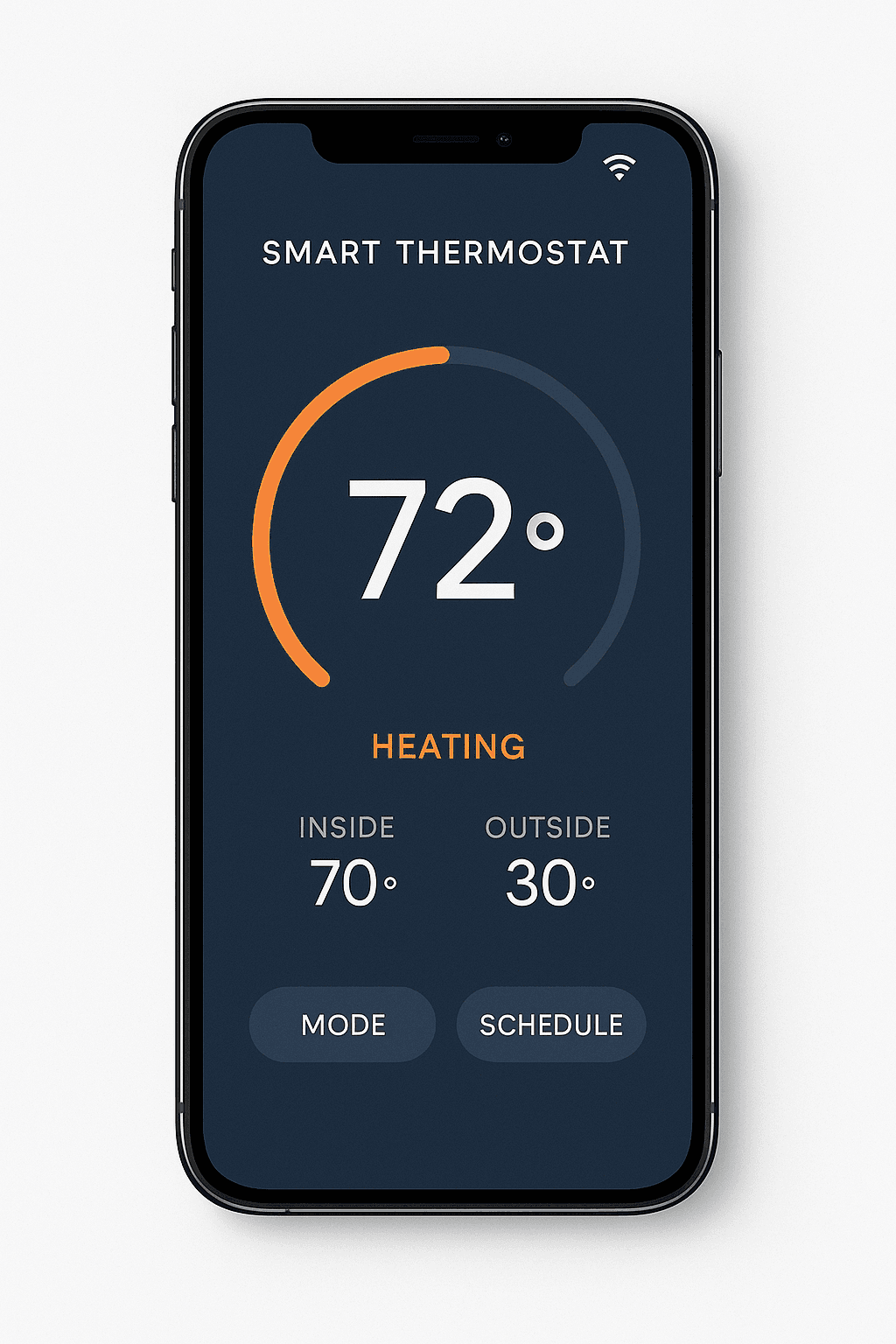The Ultimate Guide to Thermostats 🌡️
Ever wondered about that little box on your wall or the crucial part in your car’s engine? It’s a thermostat, a small device with a massive impact on our comfort, safety, and efficiency. This guide breaks down exactly what a thermostat is, how the different types work, their history, and their most critical applications.
What is a Thermostat? A Precise Definition
At its most fundamental level, a thermostat is a control device that automatically regulates temperature. It accomplishes this by sensing the ambient temperature of a physical system (like a room, an engine, or an oven) and comparing it to a desired temperature, known as the “setpoint.” If the measured temperature deviates from the setpoint, the thermostat performs actions—typically by opening or closing an electrical circuit—to bring the system’s temperature back to the desired level.
It’s a common misconception that a thermostat produces heating or cooling. It does not. Instead, it acts as the mission control center, the commander that gives orders to the actual heating and cooling equipment. For example, it tells your furnace to ignite, your air conditioner to start its compressor, or your car’s cooling fan to turn on. Its entire purpose is to maintain thermal equilibrium without manual intervention.
In short: A thermostat is an automatic switch that turns heating or cooling systems on or off to maintain a specific, user-defined temperature, acting as the brain of any climate control system.
A Brief History: From Clunky Contraptions to Smart Devices
The concept of automated temperature regulation isn’t new. The journey began in the 17th century with Dutch innovator Cornelis Drebbel, who developed a mercury-based thermostat to regulate the temperature of a chicken incubator. However, the first commercially successful and widely adopted thermostat was invented by Warren S. Johnson in 1883. His device was purely mechanical and was designed to regulate the dampers in building furnaces.
The 20th century saw the popularization of the iconic round, mechanical thermostat featuring a bimetallic strip, a design that dominated homes for decades. The digital revolution of the late 20th century brought programmable thermostats, allowing users to set different temperatures for different times of the day, a significant leap in energy conservation. Today, we are in the era of smart thermostats, which connect to the internet, learn user habits, and can be controlled from anywhere in the world, representing the pinnacle of convenience and efficiency.
How Does a Thermostat Work? A Deep Dive into the Technology
The “how” of a thermostat’s operation varies significantly with its age and type. While the goal is the same, the internal mechanisms are worlds apart. Let’s explore the most common types.
1. The Classic Mechanical Thermostat (Bimetallic Strip)
This is the technology that powered thermostats for the better part of a century. The genius lies in its simplicity. The core component is a bimetallic strip, which is essentially a sandwich of two different metals (often steel and copper) bonded together. These metals have different coefficients of thermal expansion, meaning they expand and contract by different amounts when heated or cooled.
When the room cools, the strip cools and coils more tightly. This coiling action causes the strip to tilt a small vial containing mercury, which flows to one end and completes an electrical circuit. This signals the furnace to turn on. As the room warms up, the strip expands and uncoils, tilting the vial back, breaking the circuit, and shutting the furnace off. Non-mercury versions use a simple snap-action switch instead.

2. The Modern Digital Thermostat (Thermistors and Microprocessors)
Digital thermostats, which are standard today, offer far greater precision and functionality. They replace moving parts with solid-state electronics.
- Temperature Sensor: Instead of a bimetallic strip, they use a thermistor. A thermistor is a type of resistor whose electrical resistance changes predictably with temperature. It’s highly sensitive and provides a much more accurate reading.
- Microcontroller: The brain of the digital thermostat is a small computer chip. It constantly measures the electrical resistance of the thermistor. An Analog-to-Digital Converter (ADC) translates this resistance value into a digital temperature reading.
- Decision Making: The microcontroller compares this digital temperature to the user’s setpoint. If the temperature is too low, it sends an electrical signal via a relay to turn on the heat. If it’s too high, it signals the air conditioner. This digital control allows for features like programming, screen displays, and more precise temperature management.
The Next Generation: What Are Smart Thermostats?

Smart thermostats are a revolutionary evolution of the digital thermostat. They incorporate Wi-Fi connectivity and advanced software to offer unprecedented control and energy savings.
Key Features of Smart Thermostats:
- Remote Control: Connects to your home’s Wi-Fi, allowing you to adjust the temperature from your smartphone, tablet, or computer, no matter where you are.
- Learning Algorithms: Many models learn your daily routines and temperature preferences over time. They can automatically create a schedule that optimizes comfort while saving energy, turning the temperature down when you’re away and back up before you get home.
- Geofencing: Uses your phone’s GPS location to determine if you are home or away, automatically adjusting the temperature to an energy-saving “Away” mode.
- Energy Reports: Provide detailed reports on your energy usage, helping you understand how your habits affect your utility bills and where you can save more.
- Voice Control: Integrate with smart home assistants like Amazon Alexa, Google Assistant, and Apple Siri for hands-free voice commands.
The Unsung Hero: What Does a Thermostat Do in a Car?
While often overlooked, the thermostat in your car’s engine is absolutely critical for its health, performance, and longevity. Its function is more complex than just turning something on or off; it’s a dynamic regulator of engine temperature by controlling the flow of coolant.
The Two-Phase Operation
The automotive thermostat is a small, temperature-sensitive valve positioned in the cooling system between the engine block and the radiator. It operates in two main phases:
1. Engine Warm-Up (Thermostat Closed): When you start a cold engine, the thermostat remains completely closed. This blocks the path for coolant to flow to the radiator. The coolant continues to circulate within the engine block itself. This is intentional. It allows the engine to heat up to its optimal operating temperature (typically 195-220°F or 90-104°C) as quickly as possible. A cold engine is inefficient, produces more emissions, and experiences greater wear.
2. Normal Operation (Thermostat Open): Inside the thermostat is a small cylinder containing a special wax that melts and expands at a specific temperature. Once the coolant reaches this temperature, the expanding wax pushes a pin that opens the valve. This allows hot coolant to flow out of the engine and into the radiator, where it is cooled by airflow. The now-cooler fluid is then pumped back into the engine to absorb more heat. The thermostat constantly modulates, opening and closing to maintain the engine within its ideal temperature range.

Diagnosing a Failed Automotive Thermostat
A failed thermostat can cause significant engine problems. It typically fails in one of two ways:
| Failure Mode | Symptoms | Consequences |
|---|---|---|
| Stuck Closed | Engine rapidly overheats; temperature gauge spikes into the red. Steam or boiling sounds from the engine. Poor engine performance. Check engine light may come on. | Extremely dangerous for the engine. Can lead to warped cylinder heads, blown head gaskets, and catastrophic engine failure. Requires immediate attention. |
| Stuck Open | Engine takes a very long time to warm up. Temperature gauge stays low. Poor heater performance (no hot air in the cabin). Decreased fuel economy. Check engine light (P0128 code). | Less immediately damaging but still problematic. Reduces fuel efficiency, increases emissions, and causes accelerated engine wear over time. |
Beyond the Basics: What Are Thermostats Used For?
While home climate control and cars are the most familiar examples, thermostats are ubiquitous in modern life, providing silent, automatic control in countless applications.
- Home Appliances: Your oven uses a thermostat to maintain the correct baking temperature. Your refrigerator and freezer use one to cycle the compressor and keep food safely chilled. Your water heater has a thermostat to keep water at a consistent temperature, and your clothes iron uses one to prevent scorching.
- Industrial and Scientific Fields: In laboratories, scientific incubators and chemical baths rely on high-precision thermostats to maintain exact temperatures crucial for experiments. In manufacturing, thermostats control processes like plastic molding, chemical reactions, and food processing.
- Commercial Buildings: Large-scale HVAC systems in offices, hospitals, and schools use complex networks of thermostats and sensors to manage climate across different zones, ensuring both comfort and energy efficiency on a massive scale.



